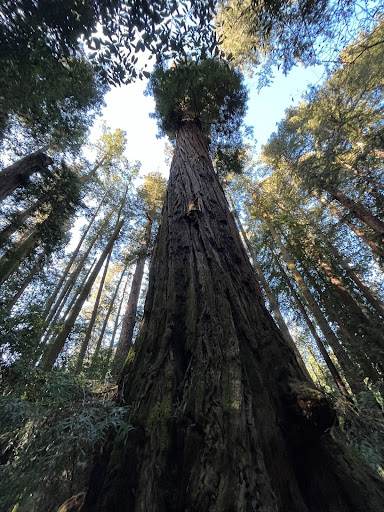
Trees of varying ages scatter the terrain– wide-trunked elders, skinnier saplings, and everything in between. The forest floor is surprisingly bare, without a substantial accumulation of decomposing material or competitive young shoots vying for resources. This is an image of a healthy, wildfire-resilient ecosystem. Not one boasting stretches of new growth and bursting foliage, but rather a population encompassing all ages, shapes, and sizes. One that can take burns in stride, and not add fuel to the fire.
Naturally-occurring fires were once a welcome tool in sustaining forest health, where low and medium intensity burns would clear out brush and understory buildup on their own, effectively “treating” the land. However, human-led fire suppression has led to a stockpile of fuel in the densely packed land of California. Then, when fires do ignite, they are often uncontrollable because they have access to large quantities of easily combustible material. A little over one million acres of forest burned in 2024, charring animal and human communities alike.
The Trump administration is showing signs of trying to fight the wildfire crisis by mandating changes in forest management practices. The president released an executive order on March 1st, titled Immediate Expansion of American Timber Production, which aims to increase logging of national forest land– a process where large trees are removed and sold for profit. The order details the reasons for the change as a way to decrease national reliance on timber imports and minimize wildfire risk. While proper thinning practices do help in suppressing fire intensity, increasing domestic harvest incentivizes the removal of the largest and most lucrative trees, which also happen to be the most fire-resilient. While executive orders don’t change the law, they direct agency priorities—and in this case, they’re rapidly reshaping land management practices for the US Department of Agriculture (USDA) and US Forest service (USFS.) How the agencies go about implementing changing timber quotas will set the tone for the Golden State forests’ ability to live with fire.
The USDA released its response to the executive order on April 3rd in a memo which declares 59 percent of national forests in a state of emergency, meaning that this land is now opened up to treatment for wildfire risk, including streamlined timber production. Shortly thereafter, the USFS put their parent department’s directions into action, setting a goal to increase harvest by 25% in the next 4-5 years. The agency also released a “National Active Forest Management Strategy” in May that outlines methods to reach the expanded harvest goal. Among the methods is the intent to “reduce survey and consultation burdens and explore options to complete compliance requirements without consultation with other State and Federal agencies,” which would expedite logging proposals, but may hinder the legal requirements of environmental review.
For Malcolm North, a research forest ecologist for USFS, the strategy transported him back in time to an era where logging ran rampant on national forest lands. “God, I felt like I was back in the 1970s,” North said. “It was like let’s get the cut out, we need to get rid of these decadent old trees and grow some stuff that grows faster.”
Quickly increasing the timber quota would likely require eliminating some of the regulatory steps that must occur before a logging proposal is approved. Deborah Sivas, an environmental law professor at Stanford, explained: “They’re trying to say, we’ve got an emergency, and on that basis, we’re going to move forward and try to both increase timber logging and in the process, avoid having to comply with a bunch of laws.”
Susie Kocher, a forestry advisor at the University of California Cooperative Extension, has been in the industry for 30 years and agrees that the state’s forests are facing an emergency. “I never thought I would see the things that I’m seeing,” she said. “The level of fires from when I started, it’s incredible the amount of disruption. So yes, I think there’s an urgent need to increase the pace and scale of forest management.”
However, expanding logging proposals as a way to combat wildfire risk can’t be the only solution if the goal is healthy, fire-resilient forest land, according to Kocher. Logging, which refers to the removal of large trees from forests to generate logs that are suitable for sale, is a practice that has remained a core vision for the United States Forest Service. Yet, larger, mature trees that are the most attractive for logging are more fire resistant due to their thick bark and later branching patterns. Thus, these would be the ones to leave behind when treating a forest for fire.
“They propose a lot of big tree logging, which is actually not the way to protect the forest. The way to protect [the forest] is to clear out the ladder fuel,” said Sivas, referring to the smaller trees and accumulation of vegetation or dead material on the forest floor that allow flames to “jump” higher into the canopies. “And no company wants that. That’s like scrap stuff, right? They want the big trees.”
Many professionals tasked with balancing ecological management with economic feasibility simply won’t take on projects to clear ladder fuel, because thinning out the smaller trees doesn’t “pay their way out of the woods,” North said. Indeed, the price to clear and burn piles of smaller trees can total around $1500-2000 an acre. Without treatment, “you’re going to condemn the stand to burning up… You get in this kind of dance with the devil,” North said, referring to the tough decision that is weighed in terms of paying the high fee for reducing fuels, or just hoping that severe fire doesn’t start up in the area before the foresters have a chance to treat the land via controlled burns or ladder fuel removal. Unfortunately for USFS, if the well-being of the environment and minimizing the threat of wildfire is prioritized, it’s unlikely that substantial financial returns will be made.
“The forest service has always tried to say, we can pay our way. We can sell enough product off of our forest to cover all of the costs,” said Sivas. “They never have done that. Not ever. The forest service runs a deficit every year.”
Kocher has seen evidence of this phenomenon first-hand. “With people I work with, two-thirds of the time you take out a tree to reduce the density, you’re not making any money,” she said. The forestry advisor mainly works with private landowners whose primary goals are habitat restoration or water quality, which is a testament to just how costly sustainable work is.
Problems emerge when the USFS prioritizes logging profits over ecological health. The easiest way to make a return on a logging project is to “high-grade” the forest, which is when only the biggest and best trees are taken from a stand. In this case, what remains is often a very young and fire prone forest. Kathleen Moxon, CEO and president of The Redwood Forest Foundation Initiative (RFFI), explained how increasing yield by 25% over a large landscape is not as bad as concentrating it in a very mature and important forest. But, she said “I don’t think that they will have the discretion to really spread it out. They’re going to do easy to get mature, high-quality wood. I am worried about the condition of the forest after that.” RFFI owns around 50 thousand acres of redwoods, where they generate revenue by selectively cutting their Redwood timber– a practice which entails leaving some old-growth trees behind to preserve canopy cover, thus leaving the forest in a healthier state than before they wielded saws.
“I don’t think there’s any initiative to do selective cutting because it’s more expensive,” Moxon said. “I suspect that they’re just going to go sell tracts of timber off their land and independent contractors of some kind will come in and cut it and take it for the wood.”
However, there are indicators that the USFS may put goals of profit to the side, and go about fulfilling the president’s vision with more care for the environment. The agency announced $23 million in grants on May 6 to transport hazardous fuel like dead trees and dense undergrowth to facilities that will process it for heat, electricity, or sustainable building material. This will not only help minimize the sheer amount of fuel that fires have access to when traipsing through national lands, but also minimize the financial burden placed on businesses and governments that intend to remove the material.
Moxon had pointed to this idea mere days after the announcement: “One nice thing that might happen is that if the feds are taking out a lot of little stuff and they can’t do anything with it, perhaps they will invest more money into finding solutions about what we could use that wood for. That would be helpful for everybody.” The USDA further bolstered the agency’s initiative with an investment of $200 million that was announced on May 29th. While the department didn’t grant an interview for this piece, a spokesperson said “In alignment with the Secretary’s direction, we will streamline forest management efforts, reduce burdensome regulations, and grow partnerships to support economic growth, sustainability and reduce wildfire risk.”
And, there has been an upward trend for the Forest Service in terms of treatment initiatives– if these are continued, there may be a future in which we will again be able to coexist with fire instead of being consumed by it. “With a notable increase in 2023, the USFS has shown tremendous progress in aiding in the response to California’s wildfire crisis throughout Region 5,” said Elicia Goldsworthy, a policy and communications manager at Green Diamond resource company. The region she is referring to encompasses all of California’s national forest land. “We hope to see this progress continue toward the goal of 500,000 acres each year.”
Kocher said “In my dream, we would have sustainable forests where people live with fire. It could come, it could go. It’s not going to destroy the forest. It’s going to do good ecological work when it’s here, right? I don’t think there’s a fire-free future.”
If fire is going to stick around, “why and how you approach this work matters,” said Kyle Cooper, director of communications at Save the Redwoods League. Whether the Forest Service prioritizes long-term ecological resilience or short-term commercial gain may determine whether our forests withstand the next century of fire—or fuel it.

